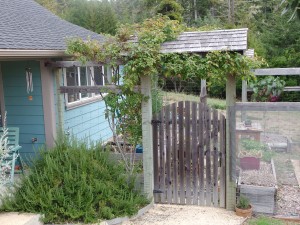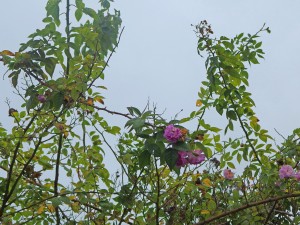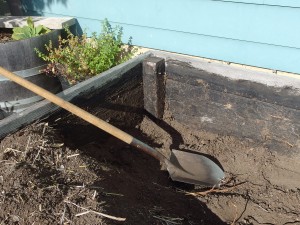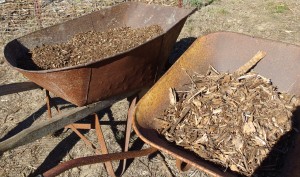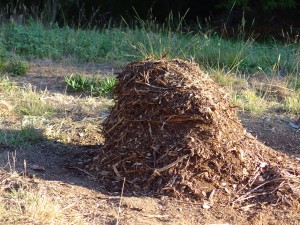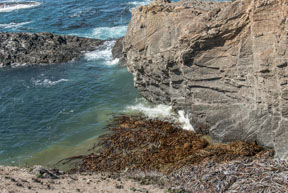Rain
This last month of our annual dry season, as grasses turn dusty brown and the trees droop, a phrase from a Gerard Manley Hopkins poem has been running through my head: “Send my roots rain.” This week the first good downpour broke the drought. I found and reread Hopkins’s poem, and recognized in it the cry of every writer who, like myself, goes through a dry spell and pleads for the rain of words and ideas.
Hopkins’s sonnet begins as a Job-like argument with God. He is angry that “sinners’ ways prosper” while he, a Jesuit priest who spends his life “upon thy cause,” sees his every endeavor end in disappointment.
The tone shifts in the second part of the sonnet. Hopkins points out the exuberant natural world:
See, banks and brakes
Now, leavèd how thick! lacèd they are again
With fretty chervil, look, and fresh wind shakes
Them; birds build …
He compares these images with his own struggles. He does not build, he says,
but strain,
Time’s eunuch, and not breed one work that wakes.
Hopkins sold himself short, of course. His poems continue to waken in the minds of later generations. But that sense of self-doubt is one all writers share. Whatever our spiritual beliefs, we can join in the prayer of Hopkins’s closing line:
Mine, O thou lord of life, send my roots rain.
You can read this sonnet, and link to other poems by Hopkins, at http://www.poetryfoundation.org/poem/173669
Battle of the Rose Roots
I should have learned from experience. Years ago, I wondered why plants near a hedge in my Palo Alto garden weren’t doing so well, in spite of soil amendments, regular watering, and other tender loving care. Investigating closer, I found that below the soil surface was a dense mass of tiny white roots. The nourishment stealer was a Banksia rose that had flourished in the hedge for fifty years.
You would think I’d learn and remember. But no … As we designed a deer-fenced vegetable garden for our new home on the edge of the forest in Mendocino, we decided that a covered gate, an English lych-gate, would be a charming touch. And wouldn’t it be romantic to have a rose climbing over it? I’ve always been fond of “Mrs. Cecille Brunner” with its exquisite miniature pink buds.
I planted a climbing “Mrs. B” in a half wine barrel just inside the gate, out of the deer’s reach. Years passed. At a friend’s house I admired another pink climber. She told me its name, “Seven Sisters,” and offered a cutting. The local legend, she told me, was that this rose was originally brought to the Northern California coast by a Russian princess in the early 1800s. Possibly she was the well-born wife of Ivan Kuskoff, commander of the Russian American Company fur trading post at Fort Ross, whose house is still standing, and is now a National Historic Landmark. According to the story, Madame Kuskoff gave cuttings of “Seven Sisters” to friends, who gave cuttings to friends, and so it moved up the coast. I see it everywhere in the gardens of old coast homes, and have met the woman who gave my friend her cutting.
But I digress. Needless to say, my cutting of “Seven Sisters” also found a home in a wine barrel inside my fenced garden. It became a yearly task to prune these enthusiastic climbers before they totally blocked the sun from the vegetables.
This year “Seven Sisters” decided to bloom again just as I was getting out my pruning shears, so she’s still a wild tangle.
But tidy on top doesn’t mean disciplined underneath. This season I noticed that the vegetables in raised beds near the roses were stunted and sad. One scoop with the shovel showed the cause. Nothing for it but to dig out the entire bed.
There’s a layer of hardware cloth on the bottom to keep out the gophers (that’s another story). I’m hoping a couple of layers of weed cloth will deter the rose roots, at least for a few years. My friend, a Master Gardener, laughed when I told her. “You’re the eternal optimist, aren’t you?” she said.
Compost
I love the miracle of compost. There is a circularity to it, the way plants in their dying return nourishment to the soil that sustained their lives. I have compost bins, of course, wire frames in which I layer garden refuse, kitchen scraps and dry material. I compost vegetable matter only, because of our resident wildlife, and keep a wire mesh lid on the currently active bin. It’s not entirely satisfactory. I cannot raise a hot enough temperature to kill all the weeks seeds. I’m envious of our local Mendocino Coast Botanical Gardens, which receives regular donations of spent grain and hops from nearby North Coast Brewing Companyto boost their compost processing temperature.
Right now I’m digging out my favorite kind of compost, a huge pile of chippings from a neighbor’s tree trimming and bush pruning that has sat in the meadow behind the house for about three years. The chippings were not great. Even now, the pile contains a lot of sticks, which I have spread under my orchard trees. They’ll decompose in time, and meanwhile provide some deterrent to the meadow grasses.
Sieved out from the sticks is the treasure: rich black compost, free of weeds, to spread as mulch around the garden. The plants are smiling.
Wave/Rock
I’m jealous of Scottish visual poet Ian Hamilton Finlay.
Last Sunday morning I walked on the cliffs at Chapman Point, just south of Mendocino. Tony, who does the graphics for Mendocino Coast Writers Conference, was taking photographs that might become next year’s program cover or a display ad in Poets & Writers magazine . I contemplated spume lifting from waves as they rolled in steady rhythm against the rocks, and thought about words I might use to convey the sense of transience that pervades this dramatic boundary between earth and sea.
Back home, I started making a list: undercut, backwash, swirl, surge, strata, submerge, carve, crevice, recede, collapse, uplift, unrest, rockfall, bull kelp, blueness, sheer … A few lines started to appear:
In the curve of the undercut
at the cliff’s base
the shape of wave
I decided to let the lines sit for a while and turned to another project. My friend Mary Marcia Casoly had recently sent a link to an anthology, Shadows of the Future: An Otherstream Anthology containing two of her poems. “Vispo,” she called them, visual poetry. Not a form I knew much about, so I Googled it and found a number of sites that had definitions and examples. Visual poetry, I learned, is “poetry that cannot suffer any translation into alternative visual or typographic form without sacrificing some of its meaning and integrity… The ‘quality of presence’ we get from the work depends on visual means, such as typefaces, format, spatial distribution on the page, or the physical form of the book or book object.” (Johanna Drucker)
I opened an example at random. Immediately my entire afternoon at my desk was washed out to sea. Before me was Ian Hamilton Finlay’s “Wave/Rock” from Aspen #7. Just two words repeated: the brown rockrockrock stacked on top of each other so that the near-vertical strata are visible; the blue wave words spread and broken as they crash against the rocks.
Sweet Peas
The 2012 Mendocino Coast Writers Conference ended last night. This morning I picked sweet peas. Over my four-day absence to run the conference, the stems that had been in bud were in full flourish, and the row of pea plants sprawled even more rampantly over chard and carrots in my vegetable garden. I picked enough to refill vases of crumpled has-beens in my house, enough to give away to a friend, enough to fill yet more vases. I pressed my nose into the bouquet, sweet as the hugs of farewell and murmured words of thanks at the conference’s closing dinner.
The scent restored my faith in myself, both as the director of a successful conference, and as a grower of sweet peas. Back when I was a child in school, growing sweet peas was part of the curriculum, like spelling and arithmetic. Each year the Important Visitor would bring the signup sheet and reveal the wondrous names of new varieties. On Seed Day the visitor would return. Precious pennies would be offered up for hard black miracles. The visitor would give instruction in the mysteries of sweet pea growing. We must dig a trench two feet deep. The layer of compost in the bottom of the trench must be at least six inches before we shoveled back the dug and loosened earth. We must soak the seeds in water overnight, then plant exactly one inch deep, and four apart.
The best on Judgment Day took front row place at the flower show, a ribbon tucked beneath a jam jar that held three specimens, each with four blooms on a long stem. My jar sat humbly at the back. I was racked with guilt for shorted measure on the trench. The ground was hard, and my arms ached. My Dad’s compost pile yielded only a thin layer of partially composted weeds. I had tossed in some fresh grass clippings, but even those did not make up the required six inches. The seeds germinated, but the plants were spindly, and none of their flower stems boasted more than three blooms.
The guilt stayed with me all my life. Not enough my love for their bright beauty, not enough my penitence. I was cast down.
This year I decided to try again. A raised vegetable bed had an empty row next to a sheltered wall covered with a strong wire trellis. Remembering my past efforts, I figured that would be enough space. I dug in a bag of soil conditioner with an impressive ingredients list: composted firbark, chicken manure, earthworm castings, bat guano and kelp meal. I planted my seeds, an old-fashioned mix from Renee’s Garden, careful to places them one inch deep and four apart.
The seeds grew. And grew. I wound string from post to post to hold the plants against the trelllis. More string. A length of chicken wire that bulged and sagged. A couple of tomato frames. Soon I gave up. The chard was running to seed anyway, and the carrots were mature enough to survive the shade.
This morning as I teetered on a step-stool to pick the flowers, the thought came to me that their exuberant growth was akin to the joy conference participants were expressing. The Mendocino Coast Writers Conference has as its mission to offer a place where writers find encouragement, expertise and inspiration. This year it all came together. A brilliant group of faculty shared their expertise with participants dedicated to improving their craft, nurtured by a team of volunteers so cohesive that the flow of events was seamless.
Today we’re all exhausted and resting up. Tomorrow we start planning MCWC 2013.
Transience
The print that hangs on my study wall is old now, as I am. When I look at it I remember seeing the original painting, Georges Rouault’s “The Old King,” in London in the early 1960s. It was on loan from the Carnegie Museum of Art, part of some big exhibition. The Tate or the National Gallery, I don’t remember which. A crowd of viewers. The friends I was with moved on to other rooms in the gallery. I stood rooted in front of the picture, tears streaming down my face. Read the rest of this entry »
Requiem for a Great Horned Owl
A warm late summer afternoon at Stanford University. I’d found a shady grove to sit and eat my lunchtime sandwich. As I strolled back to my office in Encina Hall, the administration building, I noticed several co-workers clustered under the huge live oak in front of the building, hugging each other and gazing at something on the ground. Uneasy, I hurried to join them. The looks on my friends’ faces confirmed my fears. ”Our” Great Horned Owl, who regularly roosted in the oak, lay crumpled on the ground. Read the rest of this entry »
Anniversary of a Departure
Fifty years ago today, my husband Tony and I said farewell to family on the quay in Wellington, New Zealand, and walked up the gangplank of the ocean liner Johan Van Oldenbarnevelt, drawn by that migratory urge young New Zealanders have to explore the other side of the world. This poem says a little about how it felt.
LEAVING NEW ZEALAND
I am Katherine Mansfield come again
on that slow ship out of Wellington.
Taste of bile in my mouth, I endure
the airless heat of the lower decks
rank with galley smells
and the deep-throated thump of engines.
The ice-slick of my daughter’s death
stumbling my speech,
I sit with parties playing Scrabble on the deck
where Indonesian stewards in white jackets
rattle tea-trolleys.
Evenings, I watch for that streak of light
as sun plunges into viscous sea.
Then sudden dark.
Familiar stars of my Antipodes
recede southward.
In their place, carved mahogany panels
that fill the walls of staterooms and stairways:
solemn eyes of strange beasts
peer from behind carved vines,
birds in extravagant plumage
perch on the edge of my dreams.
Juncos
A flock of twenty to thirty Oregon Juncos around the house yesterday, the most I’ve ever seen together. Such handsome, busy little birds. It gives me pleasure to know that the habitat we’ve created provides sustenance.
Remembering the Silence
An excellent piece in Mother Jones on the 39th anniversary of Roe vs. Wade brought to mind my own memories of growing up in the silence around even the word “abortion.” This poem was first published in CALYX.
ANOTHER STORY ABOUT LOVE
I tell him about
the story in my mother’s letter:
a girl I knew last year in high school
dead, a botched abortion,
septicemia,
the police phoning her parents,
saying Come and get your kid.
First time I’d heard the word
abortion.
I ask him what it means, hear
the silence around it,
his silence as we walk by the river
late at night
near his dorm room
rank with beer bottles
and dirty socks,
where Eartha Kitt sang for us
Birds do it, bees do it…
A wooden bench,
the slop, slop of the river.
His hand explores my thigh.
My leg closes against him,
saying no,
I don’t want to die,
not yet.
